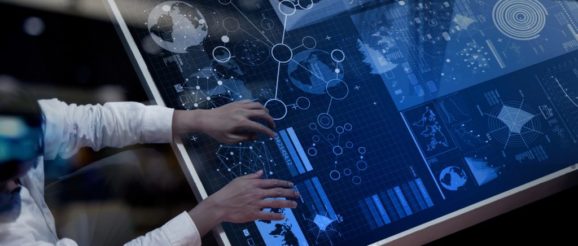Trends and Innovation in the Energy & Materials Industry


YOUR QUESTIONS ANSWERED
If there is one constant in the Energy & Materials industry it is the onward march of change. Increasing competition globally is seeing many companies innovating faster to deliver new and differentiated products to their customers, while others are diversifying their portfolios into new business areas. As this is happening, the growing focus on sustainability is seeing them push to become ever more efficient in how they engineer, construct and operate.
Recently, a panel of Dassault Systèmes experts came together to answer some of the most urgent questions facing the Energy & Materials (E&M) sector today. They shared extensive insights into issues that are vital to the competitive success of E&M firms worldwide and clarified some key steps for enabling profitable innovation through digital transformation. The following are select highlights.
WHAT INNOVATION TRENDS AND DRIVERS ARE YOU SEEING AS E&M COMPANIES SEEK TO BECOME MORE COMPETITIVE?
Thomas Grand (Vice President, Energy & Materials Industry): Competition and the drive for greater sustainability is pushing companies to define new business models. A major trend for chemical companies, for example, is to move towards selling materials and formulation properties and become “specialty-as-a-service” providers. This allows them to differentiate further from the competition and develop innovative business models with faster time-to-market, serving more specialized niches with higher added value. Advances in science and technology are making this possible, with software increasingly replacing physical experiments.
WHAT ARE THE DANGERS OF WAITING ON THE SIDELINES WHILE OTHERS PURSUE BUSINESS TRANSFORMATION INITIATIVES?
Mohamed Sharaf (Energy & Materials Senior Industry Consultant): For conservative companies, waiting to see what happens can bring opportunities to learn from the failures of others. The danger is that when the company wants to transform it will be too late. In business transformation initiatives, the biggest hurdle is people change management. Getting people to embrace new ways of working entails changing the company culture and this takes time, so starting early is important.
WHAT ADDED VALUE COULD E&M COMPANIES UNLOCK FROM THEIR DATA, WHICH THEY CAN’T DO WITH THEIR CURRENT TECHNOLOGIES?
Stefan Ceulemans (Technical & Solutions Director): Data-driven continuous improvement enables a high level of process standardization, maximizing efficiency and decreasing variability in quality. On top of managing the data better, it’s about managing it differently. Many companies think that applying the same methods to more data will bring more value. Others are seduced into thinking that if they put all their data into a data lake, artificial intelligence will solve all their problems. In reality, you have to do both. You need a well-structured, fully defined referential on which you put your data. Then you can add advanced AI and keep running new algorithms to discover knowledge that is less intuitive.
HOW CAN CHEMICALS AND OIL AND GAS COMPANIES BECOME MORE AGILE SO THEY CAN BE MORE RESPONSIVE TO THE NEEDS OF THEIR CUSTOMERS AND CHANGING DYNAMICS IN THE MARKETPLACE?
Thomas Grand: Companies have expanded drastically in terms of size, teams and global operations, and this results in specialization – and overspecialization – of the business units and teams, each relying on specific methodologies and tools, in collaborative and technical silos. Today, the challenge is to recreate the cohesive collaboration efficiency and agility they had in the early days, while scaling it up to the new normal. That means beyond the company, towards its ecosystem. This is primarily a challenge of modelling the interaction between different specialists, disciplines, tools and data, along the golden thread of mutually interdependent critical business processes. When processes come first, everything gets back in control.
HOW CAN COLLABORATION HELP COMPANIES TO INNOVATE FASTER AND DIFFERENTIATE THEMSELVES MORE FROM COMPETITORS?
Mohamed Sharaf: Internal collaboration enables the whole company to become more innovative, and technology exists to enable that. But external collaboration with suppliers and regulators also plays an important role. It enables the company to make sure it can prove its compliance with changing regulations, and it allows them to participate as a buyer or supplier in a platform- enabled marketplace. Big companies, especially, need a platform that enables them to provide their specifications for suppliers to search and allows suppliers to share the specifications of existing products for buyers to find.
WHAT’S THE BEST MEANS OF IMPROVING CONNECTIVITY BETWEEN DESIGN, PRODUCTION AND OPERATIONS?
Thomas Grand: Go horizontal. Pivot from a discipline-centric approach that delivers a local optimum, to a process-centric approach that delivers a global optimum. This is achieved by designing a robust information model that can support lifelong mission-critical processes, and that first means understanding those processes.
IN THIS UNCERTAIN AND COMPETITIVE BUSINESS ENVIRONMENT, DESCRIBE THE SUCCESSFUL E&M COMPANY OF THE FUTURE
Thomas Grand: Tomorrow’s successful E&M company is a fully model-based enterprise with a digital twin of the organization, its processes, its assets and its people.
Mohamed Sharaf: Successful companies will leverage their most important asset – knowledge – keeping it in a searchable manner with well-regulated access rights and following the latest standards for connecting solutions with each other
Stefan Ceulemans: The most successful E&M companies will be the ones that can create an enterprise ecosystem both from a technical and from an organizational standpoint. Transparency, enabling and nurturing new communication channels, empowering people, democratization of specialty skills, in-context information and user-specific experiences and work environments are the necessary traits of such underlying company structure and support systems.
Read the full interview here
